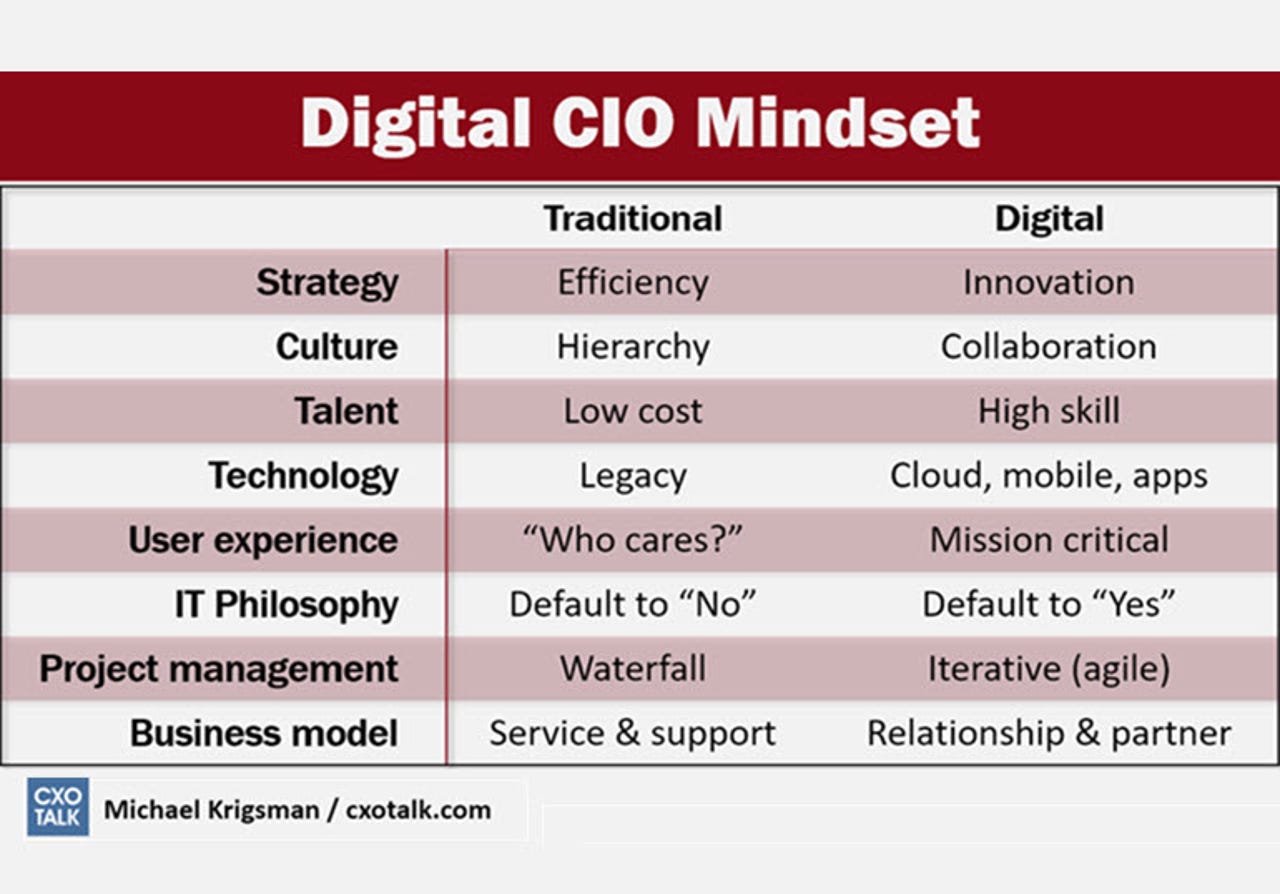CIO workshop: Become a digital leader


Digital CIO Mindset
CIOs face the challenge of maintaining technology and infrastructure while participating in corporate innovation. In today's digital world, organizations expect the CIO and IT to possess technology expertise coupled with deep knowledge of business operations and strategy. It is a challenge that the best CIOs do master, however.
I asked the Chief Technology Officer of Deloitte, Bill Briggs, to share his thoughts on how CIOs can take advantage of the great opportunities presented by digital transformation. These opportunities demand an IT cultural shift from the proverbial "default to no" attitude toward genuine collaboration with the business. CIO survival depends on putting the "default to no" behind us.
A recent survey of 1200 CIOs by Deloitte describes three CIO archetypes:
- Trusted operators focus on efficiency and performance
- Change instigators lead transformation efforts
- Business co-creators support revenue and growth
During our conversation, Briggs explained these archetypes and described the implications for CIOs. Most importantly, CIOs should identify their own goals and then ensure their approach meshes with what the organization needs. Expectation mismatches can be a source of friction and create obstacles to achieving goals.
In the short video embedded above, Briggs shares his advice and explains how CIOs can take advantage of the opportunities associated with digital business. Deloitte believes that " right-speed IT" can help the CIO bring together efficiency and innovation.
This conversation is part of the CXOTALK series. You can also watch our full discussion and read a complete transcript.
Explain the three CIO archetypes
We just published a global CIO survey and found that there are three big archetypes of CIOs.
There's an operator, which is focused on efficiency and driving the traditional things I think IT departments were asked to do: how do we get more reliable, predictable; how do we have better accuracy, to spend, cost containment; so there's an operator archetype.
There's a business co-creator archetype, which is, "How do we align with strategic initiatives and drive real change?"
And then there's the change instigator, who is the catalyst for understanding and translating to the "so what;" driving the imaginative, deliberative piece of it.
We interviewed 1,200 CIOs and found it's an even mix between them all. When you ask them [about] aspiration, it over-indexes for business co-creator and change instigators.
We shifted from fifteen years ago, when I said it's a hard job and I wouldn't recommend my kids getting into it. In 2016, it's one of the most exciting jobs that you can have if this confluence of opportunities is realized the right way.
How can CIOs take advantage of these opportunities?
Technology is the heart of all the change you see in front of us but we have to get there from today. As we talk about advanced technology adoption and transformation, we've got to find a way to unlock the foundation and make it agile.
Design is more important than ever. Integration, bringing all these parts together is more important than ever. Architecture is more important than ever. Understanding what's coming next; the sensing, the scanning, the vetting, and bringing that to the business with an idea of what it means for your industry, for your company, for your business.
All of those are the most important things that any company should do and do well. Who better to do it than the CIO, where she or he owns that agenda and knowledge?
But, what you're doing today isn't enough; the IT function itself is going through a transformation.
How will the CIO role evolve?
Technology-minded CIOs have to understand how we can do things differently than in the past.
Tech fluency and tech IQ is not just important to the CIO and the IT department, it's increasingly important to the broader business. We see companies increasingly invest the tech fluency or the tech savviness or the tech IQ of their organization at large.
We use a construct called "right-speed IT." Others have used bimodal, or two-speed IT. Agile is becoming the new norm and it's probably hybrid Agile because a lot of what you have to do in legacy systems don't lend themselves to the same speed as the pure digital cloud development.
So, how do I balance, and truly adopt Agile? It requires a significant change in my IT shop and how the business interacts with IT to deliver a project and program.
It means I must instill a culture of curiosity and learning in my shop. And, in myself to stay relevant and credible. It means I have to invest in tools and use DevOps as an umbrella for a lot of things. I need to automate testing in a way that I probably can't do at scale today. I need to automate release management, so there is less hands-on, manual labor on keyboards. I need to invest in autonomic processes that help IT run and free up my people to do more important things.
Not just being the order-taker, when the business has decided to invest in a space, or even worse, the business decides to invest and already contracted the vendor to do it.
The CIO, the IT department, should be the spark for imagination and certainly should help drive the solution, shaping the right collection of technology. And then, owning that whole deliver-and-run cycle, but doing it faster.
Right-speed IT. Sometimes my tagline or kicker is, "The only right speed is faster." But, the idea that there are two extremes and never the twain shall meet is fantasy. This hybrid model has to win.
Please see the list of upcoming CXOTALK episodes and enjoy interviews with the world's leading innovators.